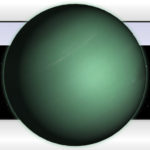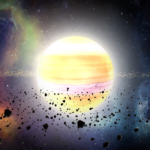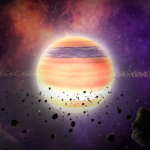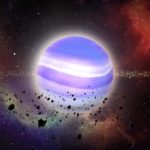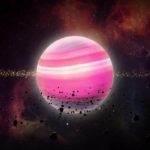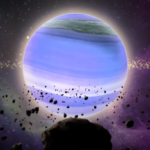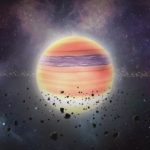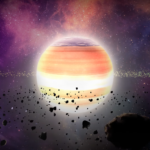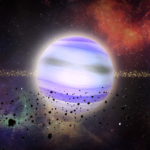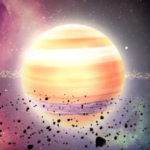These are the gas giants.
–
Jovian Group
(“Gas Giants”) J (giant), I (super-g), S (ultra-g), T (ultra-g to brown dwarf)
mass 10 to 4,000 Earth, ( 0.03 to 13 Jupiter).
Atmospheres: thick hydrogen and helium envelopes.
cores rock , ice, range from <1 Earth mass to 7.
mass 10 to 4,000 Earth, ( 0.03 to 13 Jupiter).
Atmospheres: thick hydrogen and helium envelopes.
cores rock , ice, range from <1 Earth mass to 7.
Sub-Jovian
mass 0.03 – 0.48 Jupiter. Class I (Uranus, Neptune)
atmosphere typical dense , hydrogen and helium,
mass a large portion is ice and rock core. Some have compressed liquid water oceanic mantle.
Sokarian
atmosphere typical dense , hydrogen and helium,
mass a large portion is ice and rock core. Some have compressed liquid water oceanic mantle.
Sokarian
orbits tight solar
atmospheres upper largely filled with silicate clouds. Extreme examples may actually be too hot to support upper cloud layers.
Poseidonic,
atmospheres upper largely filled with silicate clouds. Extreme examples may actually be too hot to support upper cloud layers.
Poseidonic,
orbit within snow-line,
atmospheres large amounts of water vapor.
Neptunian,
atmospheres large amounts of water vapor.
Neptunian,
orbit beyond snow-line,
atmospheres often relatively quiet upper, overlain by a methane haze,
color blue to green.
Near upper atmospheric layers may be quite volatile, however, being driven more by the internal heat of the planet than by any solar energy received.
atmospheres often relatively quiet upper, overlain by a methane haze,
color blue to green.
Near upper atmospheric layers may be quite volatile, however, being driven more by the internal heat of the planet than by any solar energy received.
Dwarf-Jovian Class J (Saturn, Jupiter)
mass 0.06 – 0.8 Jupiter. The greatest portion of their masses are concentrated within their gaseous envelopes, but they still have a low enough gravity to swell from stellar heating. The more massive examples will have layers of liquid metallic hydrogen or helium surrounding their cores.
Osirian
mass 0.06 – 0.8 Jupiter. The greatest portion of their masses are concentrated within their gaseous envelopes, but they still have a low enough gravity to swell from stellar heating. The more massive examples will have layers of liquid metallic hydrogen or helium surrounding their cores.
Osirian
orbits tight solar,
atmospheres upper largely filled with silicate clouds.
Extreme examples may actually be too hot to support upper cloud layers.
Brammian,
atmospheres upper largely filled with silicate clouds.
Extreme examples may actually be too hot to support upper cloud layers.
Brammian,
orbit within snow-line,
atmospheres large amounts of water. Of all the Jovians in this orbital region, these are the most likely to develop atmospheric-based life, although it rarely evolves past simple microbial forms.
Khonsonian,
atmospheres large amounts of water. Of all the Jovians in this orbital region, these are the most likely to develop atmospheric-based life, although it rarely evolves past simple microbial forms.
Khonsonian,
orbit just outside snow-line,
atmospheres low instance of water. Upper is highly altered by the presence of ammonia-based life
ammonia-rich
Saturnian
atmospheres low instance of water. Upper is highly altered by the presence of ammonia-based life
ammonia-rich
Saturnian
orbit beyond snow-line,
atmospheres dynamic, often obscured by methane and ammonia.
atmospheres dynamic, often obscured by methane and ammonia.
Meso-Jovian Class S
mass 0.7 – 2.5 Jupiter. The greatest portion of their masses are concentrated within their gaseous envelopes, high cloud surface gravities.
cores planet-sized surrounded by layers of metallic liquid hydrogen,
mass 0.7 – 2.5 Jupiter. The greatest portion of their masses are concentrated within their gaseous envelopes, high cloud surface gravities.
cores planet-sized surrounded by layers of metallic liquid hydrogen,
composed of metals, carbon, and ices.
atmospheres almost always turbulent and lacking any haze layer of consequence.
Junic
atmospheres almost always turbulent and lacking any haze layer of consequence.
Junic
orbits tight solar,
atmospheres upper largely filled with silicate clouds.
Extreme examples maybe too hot to support upper cloud layers.
Jovic
atmospheres upper largely filled with silicate clouds.
Extreme examples maybe too hot to support upper cloud layers.
Jovic
orbit beyond snow-line,
atmospheres dynamic.
atmospheres dynamic.
Super-Jovian Class T
mass: 2.5 – 13 Jupiter; enough mass to compress cores into electron-degenerate matter. Despite their great masses, the sizes of these worlds rarely extend much beyond that of Jupiter; the notable exceptions are those which experience atmospheric expansion from extreme solar heating.
Super-Junic
mass: 2.5 – 13 Jupiter; enough mass to compress cores into electron-degenerate matter. Despite their great masses, the sizes of these worlds rarely extend much beyond that of Jupiter; the notable exceptions are those which experience atmospheric expansion from extreme solar heating.
Super-Junic
orbits tight solar,
atmospheres upper largely filled with silicate clouds.
Extreme examples maybe too hot to support upper cloud layers.
Super-Jovic
atmospheres upper largely filled with silicate clouds.
Extreme examples maybe too hot to support upper cloud layers.
Super-Jovic
orbit beyond snow-line,
atmospheres dynamic.
atmospheres dynamic.
Chthonian (no class?)
mass: 0.015 – 0.24 Jupiter.
exposed cores of Jovian worlds which lost their gaseous envelopes through solar evaporation. typically occurs to older Jovians in tight solar orbits, or that have been greatly affected by the evolution of their primary star.
mass: 0.015 – 0.24 Jupiter.
exposed cores of Jovian worlds which lost their gaseous envelopes through solar evaporation. typically occurs to older Jovians in tight solar orbits, or that have been greatly affected by the evolution of their primary star.
–
Superclass I-J,S-T
Class J
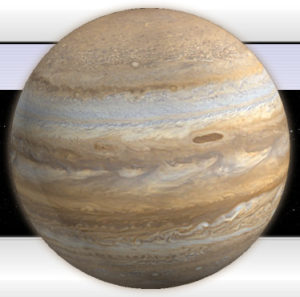
Terms: Jovian, gas-giant
Age: 2-10 BYO, intermediate
Orbit: average solar
Diameter: 50,000,000-85,000,000 km, large
Mass: 14-17 Earth masses
Solar System Zone: Cold
Surface: liquid metallic hydrogen
Composition: hydrogen
Temperature: N/A
Day / Night: N/A
Light-side / Dark-side: N/A
Gravity: ~.9-1.2 G
Tectonics: N/A
Atmosphere: quite thick
Composition: mainly hydrogen and helium
Density: quite dense
Pressure: (atm) >100 atm, extremely turbulent
Core: possibly small, solid, rocky, or metallic hydrogen
Hollow: Yes
Composition: hydrogen
Abundant / rich in: N/A
Evolution: N/A
Life: avian, cetacean
Appearance:
From Space: hazy monochromatic
Examples: Uranus, Neptune, Q’tahL
–
Jovian Subclasses
Class I: Ammonia Clouds
- Orbit: outer solar system regions.
- Temperature: <~150 kelvins(120 degrees Celsius/190 degrees Fahrenheit).
- Appearance: dominated by ammonia clouds.
- Bond albedo: (around a Sun-like star) (link to Sol / Ra) predicted to be 0.57, compared with a value of 0.343 for Jupiter and 0.342 for Saturn. The discrepancy can be partially accounted for by taking into account non-equilibrium condensates such as tholin or phosphorus, which are responsible for the colored clouds in the Jovian atmosphere, and are not modeled in the calculations.
- Examples: Jupiter ,Saturn.
- Note: The temperature range requires a cool star or a distant perihelion for the planet’s orbit. The former stars might be too dim for us even to know about, and the latter orbits might be too unpronounced to notice until several observations of those orbits’ “years” (c.f. Kepler’s Third Law). Super-Jovian planets would have enough mass to improve these observations; but a super-Jovian of comparable age to Jupiter will have more internal heating than said planet, which could push it to a higher class.
Class II: Water Clouds
- Temperature: too warm to form ammonia clouds.
- Atmosphere: water vapor clouds.
- Appear: more reflective than ammonia clouds.
- Bond albedo: (around a Sun-like star) predicted:0.81. Even though the clouds on such a planet would be similar to those of Earth, the atmosphere would still consist mainly of hydrogen and hydrogen-rich molecules such as methane.
- Examples: (possible)47 Ursae Majoris b, Upsilon Andromedae d.
- Note: expected for planets with temperatures >~250 K.
Class III: Cloudless
- Orbit: inner solar system regions, ~ Mercury-orbit.
- Atmosphere: equilibrium temperatures between about 350 K (170 °F, 80 °C) and 800 K (980 °F, 530 °C) do not form global cloud cover, as they lack suitable chemicals in the atmosphere to form clouds.
- Appear: featureless blue globes because of Rayleigh and absorption by methane in their atmospheres, appearing like Jovian-mass versions of Uranus and Neptune.
- Bond albedo: low; ~ 0.12 (around a Sun-like star) due to absence of a reflective cloud layer.
- Examples: Exo-planets Gliese 876 b, Upsilon Andromedae c.
- Note: >700 K(800 °F, 430 °C), sulfides and chlorides might provide cirrus-like clouds.
- Note: Planets of classes IV and V are referred to as hot Jupiters.
Class IV: Alkali Metals
- Temperature: >900 K (630°C/1160 °F).
- Atmosphere: form cloud decks of silicates and iron deep/low, but this is not predicted to affect the spectrum of the planet.
- Abundant: alkali metals (such as sodium) substantially increase, spectral lines of sodium and potassium predicted to be prominent.
- Bond albedo: (around a Sun-like star) predicted: very low, at 0.03,because of the strong absorption by alkali metals.
- Note: Carbon monoxide becomes the dominant carbon-carrying molecule in the atmosphere (rather than methane).
- Examples: 55 Cancri b, HD 209458 b at 1300 K(1000 °C) with a geometric albedo of ~ 0 (zero).
- Atmosphere: This star hosts an upper cloud deck absorbing so much heat that ha below it a relatively cool stratosphere.
- Composition:(of this dark cloud) assumed: titanium/vanadium oxide (abbreviated “TiVO”) by analogy with M Class dwarf stars.
- Example: HD 189733 b.
- Temperature: 920-1200 K (650-930 °C).
- Atmosphere: No stratosphere has been conclusively proven yet.
- Albedo: >0.14 (possibly due to the brighter glow of its “hot spot”).
Class V: Silicate Clouds
- Temperatures: >1400 K(2100 °F, 1100 °C); hottest gas giants, or cooler planets with lower gravity than Jupiter.
- Atmosphere: silicate and iron cloud decks predicted to lie high.
- Appear: may glow red from thermal radiation.
- Bond albedo: (around a Sun-like star) predicted: 0.55 due to reflection by the cloud decks.
- Examples: (possible)51 Pegasi b, HAT-P-11b, and those other gas giant exo-planets found by the Kepler telescope.
- Note: For stars of visual magnitude <4.50 in Earth’s sky, such planets are theoretically visible to our instruments.
–
Class I

Terms: Jovian, super-giant
Age: 2-10 BYO, intermediate
Orbit: average solar
Diameter: 85,000,000-120,000,000 km, large
Mass: _-_ Earth masses
Solar System Zone: Hot / Ecosphere / Cold
Surface: molten
Composition: _
Temperature: N/A
Day / Night: N/A
Light-side / Dark-side: N/A
Gravity: 1 G
Tectonics: N/A
Atmosphere: very thick
Composition: helium
Density: very dense
Pressure: (atm) _ atm
Core: metallic
Hollow: Yes
Composition: _
Abundant / rich in: carbide
Evolution: becomes C
Life: _
Appearance:
From Space: polychromatic bands
Examples: Jupiter, Saturn
–
Class S

Terms: ultra-giant
Age: 2-10 BYO, intermediate
Orbit: average solar, 200 to 2000+ moons
Diameter: 120,000,000-380,000,000 km, very large
Mass: _-4,000 Earth masses
Solar System Zone: cold
Surface: liquid metallic hydrogen
Composition: _
Temperature: (radiate considerable heat)
Day / Night: N/A
Light-side / Dark-side: N/A
Gravity: (generate enormous gravity)
Tectonics: _
Atmosphere: very thick
Composition: hydrogen, helium
Density: very dense
Pressure: (atm) _ atm
Core: liquid metallic hydrogen
Hollow: Yes
Composition: _
Abundant / rich in: carbide
Evolution: N/A
Life: _
Appearance:
From Space: polychromatic bands
Examples: Tethe-Alla IV
–
Class T

Terms: hyper-giant, brown-dwarf
Age: 2-10 BYO, intermediate
Orbit: _ solar
Diameter: 380,000,000-500,000,000 km, extremely large
Mass: _-_ Jupiter masses; once 13+, it ignites, making a binary system
Solar System Zone: Hot / Cold, most in Cold
Surface: _
Composition: _
Temperature: _
Day / Night: N/A
Light-side / Dark-side: N/A
Gravity: _
Tectonics: N/A
Atmosphere: extremely thick
Composition: liquid hydrogen, deuterium
Density: extremely dense
Pressure: (atm) _ atm
Core: _
Hollow: Yes
Composition: _
Abundant / rich in: _
Evolution: becomes (star class) C
Life: avian-cetacean transitioning into ‘firies’ (faery, angel, elemental); lifeforms will mutate/evolve to live here as this world ignites
Appearance:
From Space: subtly glowing; appears to have a deep and prominent internal light-source
Examples: Diadem, Tethe-Alla V
–
Standard:
–
Luminous Hyper-giants:
–
